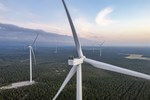10/07/2005
USA - Wind turbine blades fatal to smaller flying animals
Bats send out sound waves that bounce off objects around them so that they can navigate through life. It’s a talent unique to only a handful of creatures, including the only flying mammals – bats. So why, then, are bats incapable of navigating around the fast-spinning blades of windmills? The problem – most notable at wind farm sites in West Virginia – is so severe that the investigative arm of Congress, the Government Accountability Office, did a study of it. The report looked at both bird and bat mortality at wind farms. Its findings: Wind power does not kill a significant number of birds, but more research is needed on bats.
The United States has used wind energy, albeit sparingly, to produce electricity since the early 1980s. But the question of bat fatalities didn’t come up until a large number of bats were found dead in 2003 at the 44-turbine Mountaineer Wind Energy Center on Backbone Mountain in Tucker County, W.Va. A 2004 study estimated between 1,364 and 1,980 bats of six species were killed there during a six-week period. With wind energy being touted as a clean, green, renewable energy source, industry leaders are worried the results could taint a product that produces no pollution, no waste and doesn’t harm the land. “Any sort of environmental impact that does come up, we need to take seriously and address,” said Tom Gray, deputy executive director of the American Wind Energy Association, a trade organization.
The potential danger to birds has been known for more than a decade, when environmentalists discovered thousands of raptors were being killed at a 5,400-turbine wind farm at Altamont Pass in California. The wind farm was built along a migration route for birds of prey. A lawsuit filed against the wind farm by the Center for Biological Diversity is pending. But, Gray said, tens of thousands of birds killed annually by wind turbines is small when compared with the 1 billion birds that die annually in the United States after they crash into buildings, cars and power lines. For bats, though, the problem could be worse. They are, for their size, the slowest reproducing mammal, having only one pup each year. Because their populations are not growing quickly, large hits at a wind farm could do real damage. “Creatures like this can only sustain those types of kill rates for so long,” said Ed Arnett, lead researcher for the Bats and Wind Energy Cooperative.
Besides being able to eat more than 1,000 mosquitoes in one night, bats also are helpful in pest control on farms and help pollinate many types of plants and fruit trees. Since wind farms began, only 12 sites across the country have done studies on bats, Arnett said. Now, with the GAO report and other studies, research is beginning to pick up. Instead of just counting how many bats are dying at windmills, researchers are beginning to study bat populations and migrations at pre-construction sites. That kind of work was done this summer at two sites in Pennsylvania. After the wind farms are built, researchers will do post-construction studies to try to correlate the data.
The United States has used wind energy, albeit sparingly, to produce electricity since the early 1980s. But the question of bat fatalities didn’t come up until a large number of bats were found dead in 2003 at the 44-turbine Mountaineer Wind Energy Center on Backbone Mountain in Tucker County, W.Va. A 2004 study estimated between 1,364 and 1,980 bats of six species were killed there during a six-week period. With wind energy being touted as a clean, green, renewable energy source, industry leaders are worried the results could taint a product that produces no pollution, no waste and doesn’t harm the land. “Any sort of environmental impact that does come up, we need to take seriously and address,” said Tom Gray, deputy executive director of the American Wind Energy Association, a trade organization.
The potential danger to birds has been known for more than a decade, when environmentalists discovered thousands of raptors were being killed at a 5,400-turbine wind farm at Altamont Pass in California. The wind farm was built along a migration route for birds of prey. A lawsuit filed against the wind farm by the Center for Biological Diversity is pending. But, Gray said, tens of thousands of birds killed annually by wind turbines is small when compared with the 1 billion birds that die annually in the United States after they crash into buildings, cars and power lines. For bats, though, the problem could be worse. They are, for their size, the slowest reproducing mammal, having only one pup each year. Because their populations are not growing quickly, large hits at a wind farm could do real damage. “Creatures like this can only sustain those types of kill rates for so long,” said Ed Arnett, lead researcher for the Bats and Wind Energy Cooperative.
Besides being able to eat more than 1,000 mosquitoes in one night, bats also are helpful in pest control on farms and help pollinate many types of plants and fruit trees. Since wind farms began, only 12 sites across the country have done studies on bats, Arnett said. Now, with the GAO report and other studies, research is beginning to pick up. Instead of just counting how many bats are dying at windmills, researchers are beginning to study bat populations and migrations at pre-construction sites. That kind of work was done this summer at two sites in Pennsylvania. After the wind farms are built, researchers will do post-construction studies to try to correlate the data.
- Source:
- Online Editorial www.windfair.net
- Author:
- Edited by Trevor Sievert, Online Editorial Journalist
- Email:
- press@windfair.net
- Keywords:
- USA, wind energy, wind power, wind farm, wind turbine, rotor-blade, onshore, offshore


























